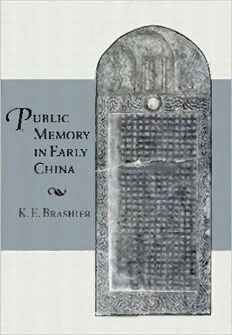Table Of Content〔
P u b lic
M emory
in Early
C hina
K.E. Brashier
B麵
一
m
w
m
o
r
y
i
n
E
a
r
l
y
C
h
i
n
a
Public Memory in Early China
t
Harvard-Yenching Institute Monographs 91
Public Memory in Early China
K. E. Brashier
Published by the Harvard University Asia Center
for the Harvard-Yenching Institute
Distributed by Harvard University Press
Cambridge (Massachusetts) and London 2014
Printed in the United States of America
The Harvard-Yenching Institute, founded in 1928, is an independent foundation dedicated to the
advancement of higher education in the humanities and social sciences in Asia. Headquartered
on the campus of Harvard University, the Institute provides fellowships for advanced research,
training, and graduate studies at Harvard by competitively selected faculty and graduate students
from Asia. The Institute also supports a range of academic activities at its fifty partner universities
and research institutes across Asia. At Harvard, the Institute promotes East Asian studies through
annual contributions to the Harvard-Yenching Library and publication of the Harvard Journal of
Asiatic Studies and the Harvard-Yenching Institute Monograph Series.
Library of Congress Cataloging-in-Publication Data
Brashier, K. E.,1965-
Public memory in early China I K. E. Brashier.
pages cm. — (Harvard-Yenching Institute monographs ; 91)
Includes bibliographical references and index.
ISBN 978-0-674-49203-5 (hardcover : alk. paper) 1. Funeral rites and
ceremonies_ China~History—To 1500.2. Burial—China—History~To 1500.
3. Collective memory~China~History~To 1500. 4. Memorials~Chinese—
History—To 1500.5. Inscriptions, Chinese. 6. China~History~Qin
dynasty, 221-207 B.C. 7. China~History~Han dynasty, 202 B.C. -220 A.D.
I. Tide.
GT3283j\2B73 2014
393'.930951—dc23
2013032662
Index by Jac Nelson
@ Printed on acid-free paper
Last figure below indicates year of this printing
20 19 18 17 16 15 14
To the instructors at liberal arts colleges tuhoy
without research libraries》teaching assistants and,
most of ally time away from their students,
still manage to add their whispers to the conversation
Contents
List of Tables and Figures ix
Conventions xi
Acknowledgments xiii
introduction: Han memorial culture i
section i: “Repeated Inking” and the backdrop of a manuscript
culture 5
section 2: “Continuous Chanting” and the backdrop of an oral
performance culture 9
section 3: Inking and Chanting share their secret of longevity
part 1: Names as positioning the self 58
section 4: The ancestors given names as locative markers 68
section 5: The ancestors surname as a spatial marker 92
section 6: Following the named lineage back through time 115
part n: Age as positioning the self 144
section 7: The age of childhood 153
section 8: The age of adulthood 158
section 9: The age of advanced years 172
section xo: The age of death 181
section 11: The age of afterlife 198
part hi: Kinship as positioning the self 209
section 12: Weakening personal agency 214
section 13: Strengthening interpersonal bonds 221
section 14: A dynamic relationship net 231
part iv: The tangible tools of positioning the self 263
section 15: Calling cards and the trafficking of names 268
section 16: The ancestral shrine and its tools of remembrance
Vlll Contents
section 17: The cemetery and its tools of remembrance 292
section 18: Commemorative portraiture as a tool of
remembrance 305
part v: The intangible tools of positioning the self 317
section 19: Reduction 321
section zo: Conversion 333
section zi: Association 349
Conclusion: “Here is where the Earl of Shao rested” 366
Notes 373
Bibliography ■ 481
Index 505
Tables and Figures
Tables
1 A sample of male and female personal names from the Zoumalou
records 71
2 The bounties of seniority,by age and administrative grade 177
3 The decreasing frequency of sacrifices 202
Figures
1 The stele of Jing Yun, magistrate of Quren,erected 173 ce,from
Yunyang County, Sichuan xiv
2 Eastern Han relief of students bearing books,from Ducheng,
Shandong 8
3 Eastern Han inscription urging descendants of a thrice venerable to
continue observing his name taboo, from Zhejiang Province 73
4 Jorg Breus “Steps of life” 148
5 A woman’s version of “The different stages of life” 149
6 Simple summary of the lifeline, as envisioned in the postmedieval
West 152
7 The stele of Xianyu Huang, erected 165 ce, from Tianjin
Municipal Region 168
8 Simple summary of the life line,as envisioned in early imperial
China 207
9 The First Emperor of Qin fails to dredge up the royal tripods, in a
late Eastern Han stone relief from Tengzhou,Shandong 282
10 An Eastern Han cemetery at Yanshi,Henan 293
11 The Kong Zhou stele, erected 164 ce, from Qufu, Shandong 300
12 A common mid-Han labeling tag, dated iz bce, from Eji-na, Inner
Mongolia Autonomous Region 300
13 The birchleaf pear beside an homage-receiving lord, from an
Eastern Han tomb at Jiaxiang, Shandong 343
14 The ranks of Confucius’s disciples (partial), as depicted in an
Eastern Han stone relief from Zoucheng, Shandong 361
15 The cedar where the Chairman Mao rested at the Ming tombs
Beijing 371

